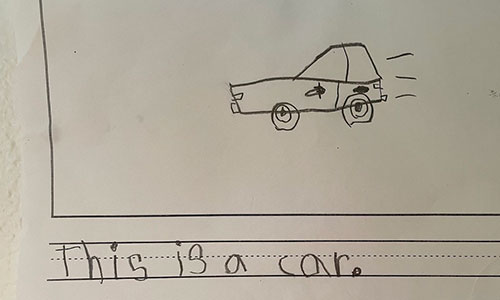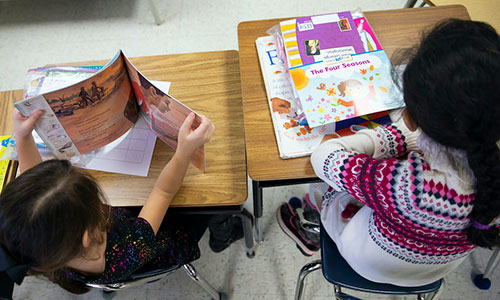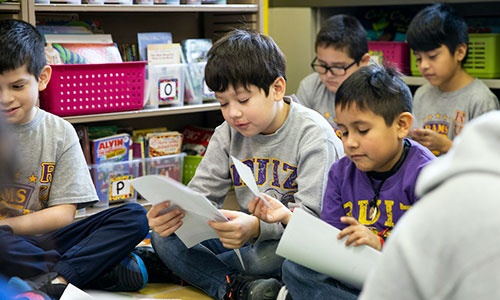
There are times I look back on my adventures as a classroom teacher and pat myself on the back. And there are other times I look back and wish I had a redo.
To be honest, I always felt like I was swimming upstream as an educator: lesson planning, participating in professional learning communities, conforming to the district’s focus on test preparation (redo, please!), addressing parent questions and student conflicts. I was busy.
Research on ways to improve my practice sat perpetually on the back burner. The closest I got was checking out the school library’s copy of The Reading Teacher magazine, and even then, I mostly focused on the classroom activities. Now that I’m in a different role in education and have time to avail myself of research, I’ve discovered that teaching reading and writing in a connected manner was one of those things I should pat myself on the back for. Writing and reading skills both stand to benefit when we have students write about what they read.
Reading and writing go hand in hand
Steve Graham, a prominent researcher who focuses on writing instruction, has written extensively about “the reciprocal relation that exists between reading and writing.” In an article from 2020, he explains that when students receive and apply writing instruction, their reading ability improves, and as students become more fluent and comprehending readers, their writing ability also improves.
This claim is well substantiated: Graham and some of his colleagues conducted a meta-analysis of studies that examined 47 literacy programs that balanced reading with writing, meaning both were taught about equally, with neither exceeding 60% of instructional time. The researchers wanted to learn whether those programs with a dual focus on reading and writing improved students’ reading and writing performance overall. And guess what? They did.
Even though I was unaware of any research on the subject when I was in the classroom, there were many reasons I chose to have students write about what they read. And now I know from the work of Graham and his colleagues that these practices were sound.
The benefits of integrating writing and reading instruction
One of my favorite ways to pair reading and writing instruction in my classroom was to invite students to write about assigned reading. I would do this for both fiction and non-fiction reading we’d done—and for pieces of varying lengths, too. Here is why I found this practice to be so beneficial:
- Writing about published works facilitates reading comprehension and reveals text connections. Having students write about what they read gave me insight into what they understood about a text, how it impacted them, and how they connected to it. Even in elementary grades, kids were eager to share their thoughts with me and with their peers, and writing gave them a way to do that.
- Published works can become mentor texts. Opportunities to have students write about what they read let me see if students were able to model good writing that had been evident in a book or article we had focused on. If the author used similes or metaphors, for example, we discussed those when we read. We talked about why authors used figurative language and how it impacted the text and the reader. If the text was informational, we discussed important academic language, what each word meant, and why authors used “big words” when discussing a subject. Then, when students wrote about those texts, I got to observe them following the model of the author, which helped them understand things like an author’s purpose, an author’s craft, genre, and text structure.
- Professional writing can model sound grammar and syntax. When students wrote about what they read, I could even see how they noticed grammar and syntax that had been modeled by the author. I would then encourage the use of those elements of writing and have them practice using them the way the author did, or in new and creative ways.
- Other people’s writing can generate ideas for student writing. The mental blocks so commonly prevalent with students seemed to lessen when they didn’t have to grab something out of thin air to write about. Writing about reading gave them something to glom onto.
- Writing about what we read can improve engagement while reading. I strived to get to know my students, as my colleague Kayla McLaughlin describes in “4 ways to get students excited about writing.” I would choose highly engaging books my kids would be interested in. Does this mean the only writing they ever did was text based? No. There are many types of writing, and students must be able to approach them all with confidence. But it does mean that almost every text had accompanying writing work and that the texts were designed to appeal to my students.
When to incorporate writing tasks
Deciding when to incorporate writing is an important part of your lesson planning. There are great opportunities for writing before your students read a text and during and after, too.
- Prereading: Ask students to write about a topic you will be getting ready to read about. My students loved the book Out of the Dust by Karen Hesse. The historical context of the Dust Bowl encouraged thinking about human consequences on the environment, the verse invited discussions about form, and the themes of hope and perseverance got us thinking about empathy. I posed different questions for students to answer prior to reading depending on what aspects I wanted to focus on. For example, if I wanted to focus on the science in the book with my fifth-graders, I would ask them to share things humans have done that have harmed the planet in their writing log. If I wanted to teach the difference between poetry, narrative, and informational texts with my fourth-graders, I would ask them to write descriptions of each of those forms. In both cases, writing before we did our reading gave me a good sense for our starting point ahead of my lessons.
- During reading: Quick writes can be effective during reading to help students reflect and give you insight into current understanding. These can be in response to guided questions, such as “Which character do you like best so far and why?” They can be answered in just a couple of sentences to help build student confidence and comfort with writing.
- After reading: Most of the time, I would give students prompts after reading, but sometimes, they were so fired up they just wanted to get some thoughts on paper. I found it useful when they were extra passionate about something to allow them to discuss it with a partner first; otherwise, the writing could be all over the place. I encouraged them to use evidence from the text to support their main points, rather than relying on their emotional reactions only, which they quickly realized strengthened their writing.
Support a sound writing process with our free resource
Informal and quick writes are valuable and have their place in your classroom. We also know from research that the process behind writing is as important as the product created. An intentional, formal process encourages deep analysis and critical thinking. Researchers David Galbraith and Veerle Baaigen refer to writing as a “knowledge-transforming” process because it activates our recently acquired knowledge and helps encode that knowledge into our memory. That’s why we have designed guidance to support you in encouraging students to think not only about what they focus on when they write but also how a sound process can help them achieve their goals. NWEA calls this guidance a writing plan, and we have outlined expectations specific to grade bands: K–1, 2–5, 6–8.
Regardless of which grade band document you open, you’ll see questions that guide students to think about purpose, audience, type of writing, organization, and the writing process. The K–1 band keeps things basic so students can better understand what to think about before writing. As we move to the 2–5 and 6–8 bands, more detail is given, especially regarding the writing process. So, for example, K–1 students will focus on keeping calm, which we know is important for beginning writers who are fearful that they don’t have enough of a grasp of spelling and grammar to get their points across. Then, in grades 6–8, students are encouraged to advance to thinking about who their writing community includes and the more exacting steps they may take as part of the process (e.g., setting daily goals, avoiding distractions, reading a draft aloud to catch typos).
The consistent focus across K–8 in our writing plan tools emphasizes that process writing can—and should—be a part of the curriculum at all grades. The changing level of sophistication across K–8 shows that the writing process should always remain developmentally appropriate.
Another thing to note: Our writing plan tools don’t just apply to the ELA classroom. Several studies, including by Graham, have shown the benefits of writing in other disciplines, like science, history, and math, because that writing deepens students’ learning of the specific content being taught. Regardless of your content area, we encourage you to explore how you can use our writing plan tools in your classroom.
A note on writing and assessment
If your school uses MAP® Growth™, you might be wondering how an interim assessment like MAP Growth fits in. While MAP Growth doesn’t assess writing, it does assess reading.
MAP Growth provides a RIT score for the reading domain. Knowing a student’s reading RIT score is lower than the proficiency norms for their grade level would be helpful when you think about what their writing scores might look like on your state summative. If the score is low, I encourage you to use formative assessment to further determine how best to differentiate instruction and build those reading and writing connections. For example, if your Class Profile report shows students’ RIT scores are low in vocabulary, choose books rich in academic language or that include figurative language in meaningful ways. Spend instructional time talking about the meaning of those words and the impact of the words on the text. Then have students write using the academic language or using figurative language to make their points.
MAP Growth also includes a language usage test that will give you insight into students’ strengths with grammar and conventions.
In closing
If you currently teach reading and writing separately, there’s no better time to reflect on how to have students write about what they read. That way, you won’t have to look back later and wish you, too, could have a redo.
I encourage you to explore opportunities for writing before, during, and after reading a text and to turn to our writing plan tools for support, including beyond the ELA classroom. Together, formative and interim assessment can help you get a good understanding for where students are in their growth as writers, and they’ll give you the information to course correct as needed.







